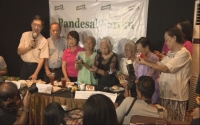Actual election turnout far lower than reported
11-1514.1415291313087.jpg)
Election turnout is often cited as an indicator of the strength of the mandate of winning candidates, but it can be a misleading statistic: Turnout is usually measured as a proportion of registered voters rather than of those eligible to vote — and census numbers show that more than 70 million U.S. citizens of voting age are not registered voters.
Al Jazeera kept a close watch on voter turnout Tuesday, mindful of the possible impact of new voter ID laws in more than 30 states that critics feared would discourage or prevent voting by poorer Americans.
Turnout proved to be lower than previous years in all but 10 states, but the reasons for that decline are many: Some states lacked competitive races to draw voters to the polls; others cut polling hours or reduced early voting periods. And, in some states, new voter ID laws could have kept some voters away. Public opinion polls such as the one released by Gallup earlier this week suggested that fewer Americans cared about this election than in previous years.
But the data also proved more complicated than we anticipated. Election turnout is often cited as an indicator of the strength of the mandate of winning candidates, but it can be a misleading statistic: Turnout is usually measured as a proportion of registered voters, rather than of those eligible to vote – and U.S. census numbers show that more than 70 million U.S. citizens of voting age are not currently registered voters.
Turnout in midterm elections measured by participation of registered voters has has fallen since 1840, according to the Pew Research Center. Voter turnout in 2010 rose slightly, but 2014 turnout is a return to the declining trend.
Sources: Turnout data from the United States Elections Project. 2014 turnout is calculated by using the votes cast for highest office in any given election. Votes cast number from AP.
Below are the changes in voter turnout, sorted in two ways. You can look at all 50 states and see the change in turnout from 2010 to 2014, and click a state for turnout in other elections. In the other tab, we’ve categorized states with voter ID laws.
About the chart
A more accurate picture of the proportion of the population involved in choosing America’s elected representatives is shown in the chart below, measuring voting against the voting eligible population (VEP) rather than simply against those already on the voting rolls. It uses data maintained at United States Election Project by Michael McDonald, an associate professor at the University of Florida and a senior fellow at the Brookings Institution. The VEP does not include people who are ineligible to vote, such as non-citizens and felons.
Data using measuring the turnout rate against the VEP also allows a more accurate assessment of the impact of new ID laws and other voting restrictions that potentially limit voter registration.
Information about the laws comes from the National Conference of State Legislatures’ roundup of voter ID laws. NCSL categorizes states with these laws in two ways: whether the state asks for photo ID and accepts forms of identification that do not include a photo; and what options the state makes available for voters unable to show a photo ID. NCSL has divided those options into strict and non-strict groups:
Non-strict: At least some voters without acceptable identification have an option to cast a ballot that will be counted without further action on the part of the voter.
Strict: Voters without acceptable identification must vote on a provisional ballot and also take additional steps after Election Day for their vote to be counted.
Editor's note: An earlier version of this story labeled the differences in voter turnout as "change." To clarify, the numbers show the percentage point differences in turnout from 2010 to 2014, not percentage changes.
Sources: Turnout data from the United States Elections Project. Information about voter ID laws from the National Conference of State Legislatures.
Related Coverage
Three laws that keep Americans from voting (Video | Oct. 28, 2014)
Jim Crow returns (Article and interactive | Oct. 29, 2014)


























Error
Sorry, your comment was not saved due to a technical problem. Please try again later or using a different browser.